THE DOGRUN
a place to share ideas


Seminole Canyon and The White Shaman Preserve
Posted by sierrahaight on 12/3/13 at 8:00 am
There are many points in time to begin telling this story. In geologic time, we could start 10 million years ago when the west Texas landscape was forming. We could start our story when the people of the Lower Pecos were making their rock art 3,000 years ago. We could start when Lake|Flato began their work with the Witte Museum, creating a new home for their People of Pecos exhibit with additions and renovations to their existing space. We could start our story in the small "town" of Comstock, Texas, where a group of LFers spent a Saturday night drinking beer around a pool table getting to know the locals just a few miles from Seminole Canyon. But, I think we will begin on Sunday morning after the group emerged from the Comstock Motel into a cool West Texas morning and headed into Seminole Canyon State Park for a day of exploring.
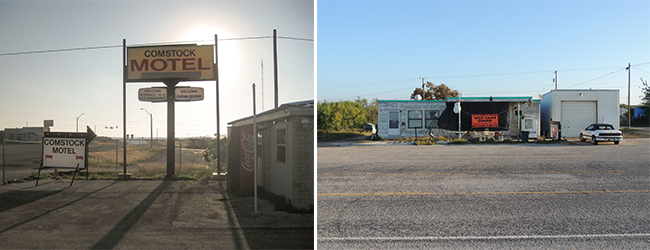 We made the trip to Seminole Canyon to see the rock art created by the People of the Pecos in the Lower Pecos Canyon Lands and in the process better understand those people and the landscape they lived in. Our tour guide was Greg Williams, the Director of the Rock Art Foundation. He moves us through the landscape, painting a picture of what life was once like. We move down into the canyon as Greg explains the world of the Lower Pecos - the landscape, the climate, the plants.
We made the trip to Seminole Canyon to see the rock art created by the People of the Pecos in the Lower Pecos Canyon Lands and in the process better understand those people and the landscape they lived in. Our tour guide was Greg Williams, the Director of the Rock Art Foundation. He moves us through the landscape, painting a picture of what life was once like. We move down into the canyon as Greg explains the world of the Lower Pecos - the landscape, the climate, the plants.
 Then we move up into the Fate Bell shelter - the largest rock shelter in the region.
Then we move up into the Fate Bell shelter - the largest rock shelter in the region.
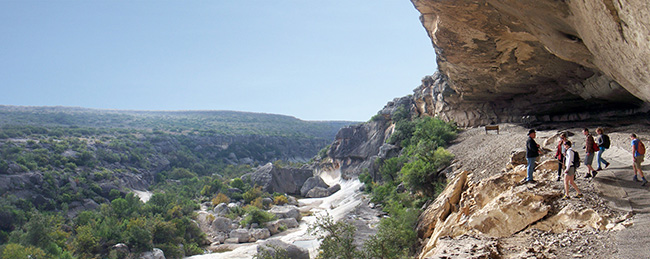 As we stare up at the rock art, Greg explains that surviving was a full time job 3,000 years ago – there was no free time for creating art. The pictographs they painted were so important they put surviving on hold to paint them. “It makes you feel small… it makes me feel small,” Greg said.
As we stare up at the rock art, Greg explains that surviving was a full time job 3,000 years ago – there was no free time for creating art. The pictographs they painted were so important they put surviving on hold to paint them. “It makes you feel small… it makes me feel small,” Greg said.
 Throughout the cave Greg pointed out lifestyle indications of the people of Lower Pecos. Mortar holes and concavities of all sizes were evident. With the range of size came the range of use: it is thought some of the deeper mortar holes were used for water storage. The cooking process was explained as quite an ordeal. They would forage for artichoke-like plants, then cook over a smoldering fire for days until the plants were ready to eat. The idea of having to wait three days for a plant to cook and the preparation of each meal made each of us appreciate how far civilization has come.
Throughout the cave Greg pointed out lifestyle indications of the people of Lower Pecos. Mortar holes and concavities of all sizes were evident. With the range of size came the range of use: it is thought some of the deeper mortar holes were used for water storage. The cooking process was explained as quite an ordeal. They would forage for artichoke-like plants, then cook over a smoldering fire for days until the plants were ready to eat. The idea of having to wait three days for a plant to cook and the preparation of each meal made each of us appreciate how far civilization has come.
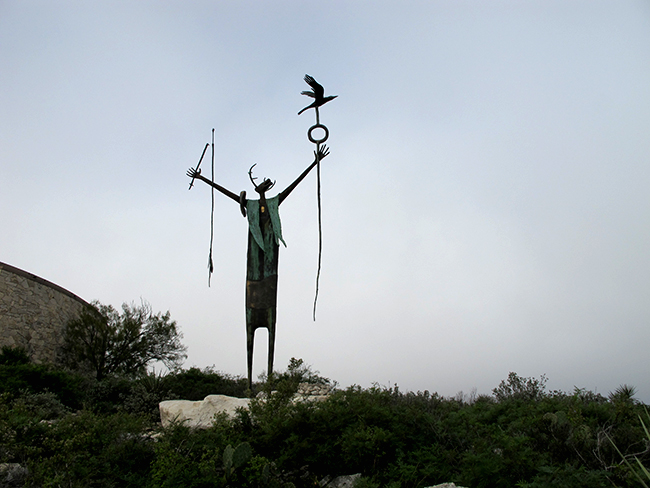 After Seminole Canyon, we headed to the White Shaman Preserve. The trail to this pictograph site is an adventure all by itself. We frequently stopped to discuss the plant life, including the medicinal use of a couple weeds. A couple LFers tried a root that acts as numbing agent - good for toothaches! One of the most memorable aspects of our trip was traipsing through the preserve, where an Oregano-like smell is ever present from one of the many plants found in the area.
After Seminole Canyon, we headed to the White Shaman Preserve. The trail to this pictograph site is an adventure all by itself. We frequently stopped to discuss the plant life, including the medicinal use of a couple weeds. A couple LFers tried a root that acts as numbing agent - good for toothaches! One of the most memorable aspects of our trip was traipsing through the preserve, where an Oregano-like smell is ever present from one of the many plants found in the area.
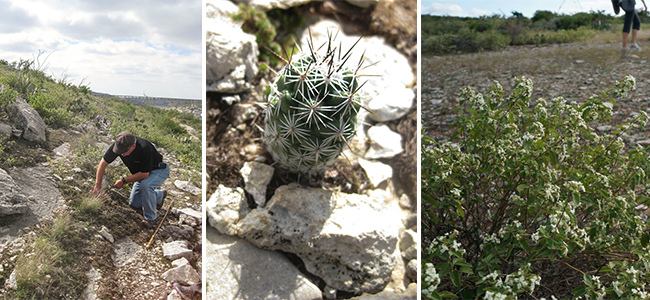 Josh described the last section of our journey as “The Stairs to Mordor” – I won’t disagree. If there was a steep incline to travel down, Greg found it for us.
Josh described the last section of our journey as “The Stairs to Mordor” – I won’t disagree. If there was a steep incline to travel down, Greg found it for us.
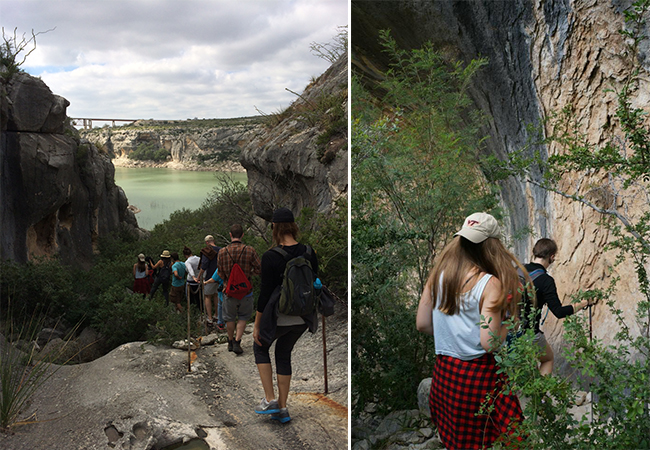 “Let’s take a short cut.” That is Greg with a few more things to show us. We leave the trail and make our way across the landscape. Everything has spikes. With boots and jeans you have to move carefully through the space – we took scratches home as souvenirs. It is hard to imagine spending every day in that environment… in handmade sandals and bare legs.
“Let’s take a short cut.” That is Greg with a few more things to show us. We leave the trail and make our way across the landscape. Everything has spikes. With boots and jeans you have to move carefully through the space – we took scratches home as souvenirs. It is hard to imagine spending every day in that environment… in handmade sandals and bare legs.
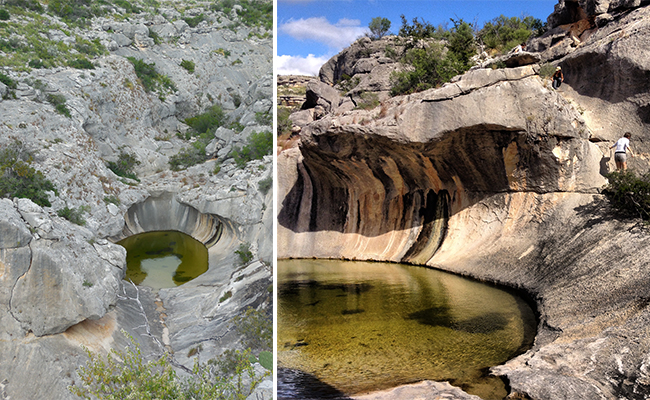 As we made our way back, Greg's shortcut took us by a canyon. As Greg was cracking jokes throughout most of the trip, I'm not sure any of us took him seriously when he told us we were going to climb down to the water hole seen from above (pictured on the left). With a rope as our guide and a little bit of sliding, we made our way down to explore.
As we made our way back, Greg's shortcut took us by a canyon. As Greg was cracking jokes throughout most of the trip, I'm not sure any of us took him seriously when he told us we were going to climb down to the water hole seen from above (pictured on the left). With a rope as our guide and a little bit of sliding, we made our way down to explore.
 As you can imagine, we could have spent days exploring this area and learning about the people of Lower Pecos. Unfortunately, we covered all of this in about 6 hours and were all yearning to learn more. Our group is already planning our next trip to visit Greg out in Seminole Canyon as we had an incredible time. We highly encourage every one to go take a tour with the Rock Art Foundation.
As you can imagine, we could have spent days exploring this area and learning about the people of Lower Pecos. Unfortunately, we covered all of this in about 6 hours and were all yearning to learn more. Our group is already planning our next trip to visit Greg out in Seminole Canyon as we had an incredible time. We highly encourage every one to go take a tour with the Rock Art Foundation.
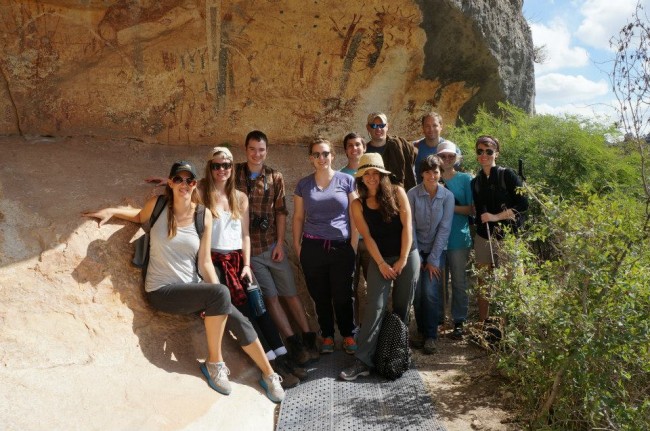
 We made the trip to Seminole Canyon to see the rock art created by the People of the Pecos in the Lower Pecos Canyon Lands and in the process better understand those people and the landscape they lived in. Our tour guide was Greg Williams, the Director of the Rock Art Foundation. He moves us through the landscape, painting a picture of what life was once like. We move down into the canyon as Greg explains the world of the Lower Pecos - the landscape, the climate, the plants.
We made the trip to Seminole Canyon to see the rock art created by the People of the Pecos in the Lower Pecos Canyon Lands and in the process better understand those people and the landscape they lived in. Our tour guide was Greg Williams, the Director of the Rock Art Foundation. He moves us through the landscape, painting a picture of what life was once like. We move down into the canyon as Greg explains the world of the Lower Pecos - the landscape, the climate, the plants.
 Then we move up into the Fate Bell shelter - the largest rock shelter in the region.
Then we move up into the Fate Bell shelter - the largest rock shelter in the region.
 As we stare up at the rock art, Greg explains that surviving was a full time job 3,000 years ago – there was no free time for creating art. The pictographs they painted were so important they put surviving on hold to paint them. “It makes you feel small… it makes me feel small,” Greg said.
As we stare up at the rock art, Greg explains that surviving was a full time job 3,000 years ago – there was no free time for creating art. The pictographs they painted were so important they put surviving on hold to paint them. “It makes you feel small… it makes me feel small,” Greg said.
 Throughout the cave Greg pointed out lifestyle indications of the people of Lower Pecos. Mortar holes and concavities of all sizes were evident. With the range of size came the range of use: it is thought some of the deeper mortar holes were used for water storage. The cooking process was explained as quite an ordeal. They would forage for artichoke-like plants, then cook over a smoldering fire for days until the plants were ready to eat. The idea of having to wait three days for a plant to cook and the preparation of each meal made each of us appreciate how far civilization has come.
Throughout the cave Greg pointed out lifestyle indications of the people of Lower Pecos. Mortar holes and concavities of all sizes were evident. With the range of size came the range of use: it is thought some of the deeper mortar holes were used for water storage. The cooking process was explained as quite an ordeal. They would forage for artichoke-like plants, then cook over a smoldering fire for days until the plants were ready to eat. The idea of having to wait three days for a plant to cook and the preparation of each meal made each of us appreciate how far civilization has come.
 After Seminole Canyon, we headed to the White Shaman Preserve. The trail to this pictograph site is an adventure all by itself. We frequently stopped to discuss the plant life, including the medicinal use of a couple weeds. A couple LFers tried a root that acts as numbing agent - good for toothaches! One of the most memorable aspects of our trip was traipsing through the preserve, where an Oregano-like smell is ever present from one of the many plants found in the area.
After Seminole Canyon, we headed to the White Shaman Preserve. The trail to this pictograph site is an adventure all by itself. We frequently stopped to discuss the plant life, including the medicinal use of a couple weeds. A couple LFers tried a root that acts as numbing agent - good for toothaches! One of the most memorable aspects of our trip was traipsing through the preserve, where an Oregano-like smell is ever present from one of the many plants found in the area.
 Josh described the last section of our journey as “The Stairs to Mordor” – I won’t disagree. If there was a steep incline to travel down, Greg found it for us.
Josh described the last section of our journey as “The Stairs to Mordor” – I won’t disagree. If there was a steep incline to travel down, Greg found it for us.
 “Let’s take a short cut.” That is Greg with a few more things to show us. We leave the trail and make our way across the landscape. Everything has spikes. With boots and jeans you have to move carefully through the space – we took scratches home as souvenirs. It is hard to imagine spending every day in that environment… in handmade sandals and bare legs.
“Let’s take a short cut.” That is Greg with a few more things to show us. We leave the trail and make our way across the landscape. Everything has spikes. With boots and jeans you have to move carefully through the space – we took scratches home as souvenirs. It is hard to imagine spending every day in that environment… in handmade sandals and bare legs.
 As we made our way back, Greg's shortcut took us by a canyon. As Greg was cracking jokes throughout most of the trip, I'm not sure any of us took him seriously when he told us we were going to climb down to the water hole seen from above (pictured on the left). With a rope as our guide and a little bit of sliding, we made our way down to explore.
As we made our way back, Greg's shortcut took us by a canyon. As Greg was cracking jokes throughout most of the trip, I'm not sure any of us took him seriously when he told us we were going to climb down to the water hole seen from above (pictured on the left). With a rope as our guide and a little bit of sliding, we made our way down to explore.
 As you can imagine, we could have spent days exploring this area and learning about the people of Lower Pecos. Unfortunately, we covered all of this in about 6 hours and were all yearning to learn more. Our group is already planning our next trip to visit Greg out in Seminole Canyon as we had an incredible time. We highly encourage every one to go take a tour with the Rock Art Foundation.
As you can imagine, we could have spent days exploring this area and learning about the people of Lower Pecos. Unfortunately, we covered all of this in about 6 hours and were all yearning to learn more. Our group is already planning our next trip to visit Greg out in Seminole Canyon as we had an incredible time. We highly encourage every one to go take a tour with the Rock Art Foundation.

